Kitagawa Utamaro's "Hour of the Rat: Mother and Sleepy Child" (子ノ刻 妾 - Ne no koku, mekake) captures one of the most tender and psychologically nuanced moments in Japanese art. This woodblock print, part of the revolutionary "Customs of Beauties Around the Clock" series (風俗美人時計 - Fuzoku bijin tokei), depicts a universal moment that transcends time and culture: a mother emerging from sleep to attend to her drowsy child at midnight.
A Glimpse into Domestic Intimacy
The scene is remarkably simple yet profound. A woman, sleepily pulling back a mosquito net, tends to her child who rubs the sleep from his eyes. Unlike the staged, idealized scenes common in Edo period art, this is authentically human—a glimpse into domestic intimacy rarely portrayed with such honesty.
The artwork resonates with viewers across centuries because Utamaro achieved what artists still strive for: capturing the subtle psychology of everyday life with both artistic elegance and emotional truth. Any parent who has woken in the night to comfort a child recognizes this moment immediately.
The Artist: Kitagawa Utamaro (1753-1806)
Master of Bijin-ga
Kitagawa Utamaro stands among the greatest ukiyo-e ("pictures of the floating world") artists in Japanese history, alongside Hokusai and Hiroshige. While his contemporaries gained fame for landscapes, Utamaro revolutionized bijin-ga—the art of depicting beautiful women.
During the 1790s, Utamaro pioneered the ōkubi-e format, filling frames with close-up portraits that focused on faces and expressions. His women were individuals with distinct personalities, not generic beauties. He portrayed women from all social classes: courtesans, mothers, servants, shrine maidens, each rendered with dignity and psychological depth.
Technical Mastery
Utamaro's technical excellence was extraordinary. He experimented with line, color, and woodblock printing techniques to capture subtle differences in skin tones, facial features, and expressions:
- Elongated, idealized forms — Slender bodies with long necks and expressive faces
- Delicate line work — Fine lines conveying the softness of skin and texture of fabrics
- Sophisticated use of color — Subtle gradations and innovative mica backgrounds
- Psychological depth — Capturing personality and mood through gesture and expression
He produced over 2,000 prints, illustrated nearly 100 books, and created about 30 paintings during his career, achieving national fame during his own lifetime in Edo-period Japan.
Did you know? Scholars speculate that many of Utamaro's prints showing the same woman and child over several years may depict his own family. This personal investment may explain the authenticity and emotional resonance of his maternal subjects.
The "Customs of Beauties Around the Clock" Series
"Hour of the Rat: Mother and Sleepy Child" belongs to Utamaro's later series depicting women at different hours of the day. Unlike his earlier "Twelve Hours in the Yoshiwara" (c. 1794) which focused on courtesans, this collection showed greater social diversity and everyday realism.
Each print featured:
- • Specific time (zodiac animals)
- • Women from various classes
- • Authentic daily activities
- • Individual characterization
The 12 Hours:
- 子 (Rat) - Midnight
- 丑 (Ox) - 2 AM
- 寅 (Tiger) - 4 AM
- 卯 (Rabbit) - 6 AM
- 辰 (Dragon) - 8 AM
- 巳 (Snake) - 10 AM
Understanding Japanese Traditional Time
To appreciate Utamaro's clock series fully, understanding Edo-period timekeeping is essential. Until 1872, Japan used a temporal hour system (wadokei) fundamentally different from Western fixed hours.
The day was divided into 12 "toki" (時), each corresponding to one of the Chinese zodiac animals. The Hour of the Rat (Ne no koku) marked midnight—the beginning of the cycle. This reflected a relationship with time tied to natural rhythms rather than mechanical precision.
The Specific Artwork
Visual Description
The print shows a mother in simple nightclothes emerging from beneath a mosquito net, captured in that liminal state between sleep and wakefulness. Her posture and expression convey drowsiness even as she responds to her child's needs. The child rubs his eyes, equally sleepy.
The mosquito net becomes a framing device, creating depth and suggesting the enclosed intimacy of the sleeping space. The woman's nightclothes are simple—this is not a performance of beauty but an authentic glimpse of domestic life.
Technical Execution
This print exemplifies the full-color nishiki-e technique at its apex:
- Multiple woodblocks, each carved for a different color
- Mica background creating a subtle shimmering effect
- Precise registration ensuring perfect alignment
- Delicate color gradations in skin tones and fabrics
- Ōban format (approximately 38 × 26 cm or 15 × 10 inches)
Where to See This Print
Examples are held in major collections worldwide:
- Metropolitan Museum of Art, New York — From the Alexis Rouart Collection
- Harvard Art Museums/Arthur M. Sackler Museum
- Various private collections
Why This Artwork Matters Today
Universal Human Experience
The midnight wake-up to tend a child is unchanged across centuries. Modern parents find themselves confronted with their own experience from 220 years ago.
Psychological Authenticity
The woman isn't performing—she's simply being human. This honesty was revolutionary then and remains compelling in our age skeptical of artifice.
Artistic Mastery
The technical excellence—delicate lines, subtle colors, sophisticated composition—represents a pinnacle of traditional Japanese technique.
Historical Insight
The print offers a window into Edo-period domestic life, showing not just clothing but the texture of everyday experience.
Influence on Western Art
When Japan reopened to trade in 1853-1854, ukiyo-e prints profoundly influenced Western art:
- 🎨Vincent van Gogh owned over 400 Japanese prints and studied them intensely
- 👩🎨Mary Cassatt created mother-child prints directly inspired by Utamaro after an 1890 exhibition
- 🖼️Edgar Degas adopted Utamaro's off-center compositions and intimate perspectives
- 🎭Henri de Toulouse-Lautrec explicitly acknowledged his debt, creating "Elles" (1896) as homage to Utamaro
Utamaro Masterpieces in Our Collection
Explore more exquisite works by Kitagawa Utamaro from the Artheon collection. These beautifully preserved woodblock prints showcase his mastery of bijin-ga and his revolutionary approach to depicting women.
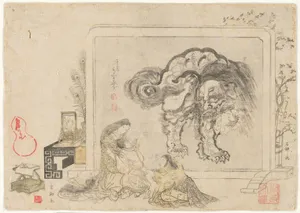
唐獅子図の衝立 |Mother and her Children in Front of a Freestanding Screen of a Chinese Lion
1786

風俗美人時計 子ノ刻 妾|Midnight: Mother and Sleepy Child
1790
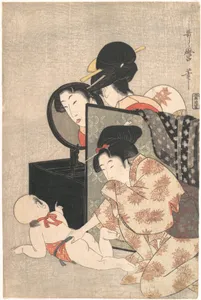
Mother and Child
ca. 1793
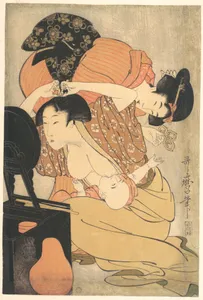
Woman and Child
ca. 1793
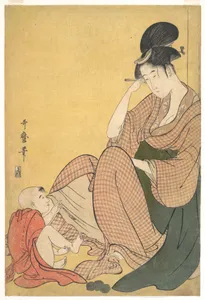
Woman and Child
ca. 1794–95
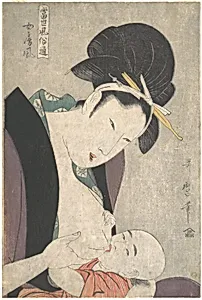
当世風俗通 女房風|Mother and Child
ca. 1790
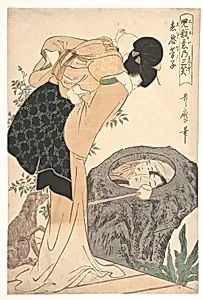
児戯意乃三笑 恵恩芳子|Mother and Child
ca. 1800
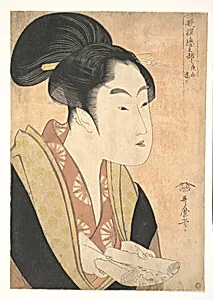
歌撰恋之部 夜毎に逢恋|A Young Woman Reading A Letter
1790s
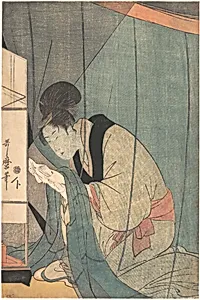
喜多川歌麿画 蚊帳の中の文読み美人|Woman Reading a Letter under a Mosquito Net
ca. 1798
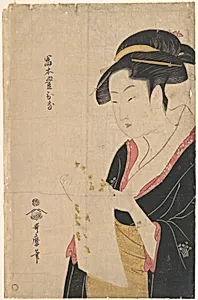
富本豊ひな|The Lady Tomimoto Toyohina Reading a Letter
1790
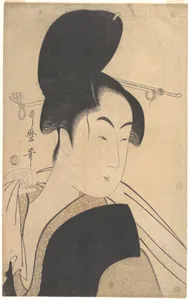
Woman after a Bath
ca. 1795
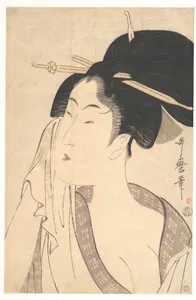
Woman Relaxing after Her Bath
1790s
Visit the Virtual Exhibition
Experience our curated exhibition "Kitagawa Utamaro: Master of Ukiyo-e" featuring the artworks discussed in this article and more masterpieces from our collection.
Conclusion
Kitagawa Utamaro's "Hour of the Rat: Mother and Sleepy Child" represents Japanese art at its finest—technically masterful, psychologically insightful, culturally significant, and universally human. It captures a fleeting moment of tenderness that resonates across centuries.
The print's significance extends beyond immediate appeal. As art, it demonstrates woodblock technique at its zenith. As history, it documents Edo-period life. As cultural exchange, it influenced Western Impressionism. As human document, it reminds us that fundamental experiences transcend time and culture.
Utamaro achieved what all great artists aspire to: creating work simultaneously of its time and beyond time, culturally specific and universally human, technically brilliant and emotionally resonant.
Further Reading
Books:
- • Edmond de Goncourt, Outamaro (1891)
- • Jack Hillier, Utamaro: Colour Prints and Paintings (1961)
- • Julie Nelson Davis, Utamaro and the Spectacle of Beauty (2007)

